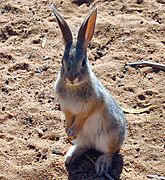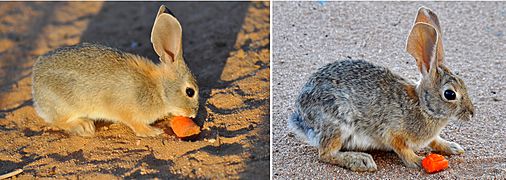Cottontail rabbit facts for kids
Quick facts for kids Cottontail rabbits |
|
|---|---|
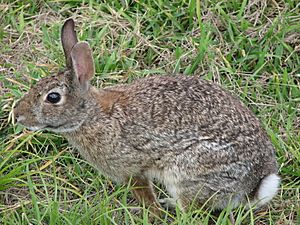 |
|
| Eastern cottontail rabbit (Sylvìlagus floridanus) | |
| Scientific classification |
|
| Kingdom: | Animalia |
| Phylum: | Chordata |
| Class: | Mammalia |
| Order: | Lagomorpha |
| Family: | Leporidae |
| Genus: | Sylvilagus Gray, 1867 |
| Type species | |
| Lepus sylvaticus Bachman, 1837
(=Lepus sylvaticus floridanus J. Allen, 1890) |
|
| Species | |
|
27, see text |
|

Cottontail rabbits are a group of rabbits found across the Americas. They belong to the genus Sylvilagus. Most cottontails get their name from their short tails, which have white undersides. When they run away, their white tails pop up, looking like a fluffy cotton ball! However, not all cottontails have this feature, and some other animals do too.
These rabbits live in many places, from North America to Central America and even parts of South America. Most species prefer to live in simple nests called "forms." Baby cottontails are born helpless, meaning they need a lot of care from their parents. An adult female rabbit can have about three litters of babies each year. This can happen in any season. The number of babies in a litter can change based on the time of year, weather, and where they live. On average, a litter has four babies, but it can be anywhere from two to eight. Sadly, many of these young rabbits do not survive to become adults.
Cottontail rabbits are also more resistant to a disease called myxomatosis compared to European rabbits.
Contents
How Cottontails Evolved
Cottontail rabbits are part of a larger family of rabbits. Their closest relative is the Pygmy rabbit (Brachylagus). They are also related to the European rabbit and other rabbits, but not as closely. Hares are even more distant relatives. Scientists study their genes to understand how these different rabbit types are connected.
What is a Cottontail's Lifespan?
A cottontail rabbit usually lives for about two years. This can change depending on where they live. Many animals hunt cottontails. These predators include domestic dogs, cats, snakes, coyotes, mountain lions, and foxes. Even squirrels might attack a sick cottontail. The most common predators are different types of birds of prey, like hawks and eagles.
Cottontails can also get tiny insect larvae called botflies, like Cuterebra fontinella. Newborn cottontails are especially easy targets for these attacks. Cottontails often use burrows that other animals have left behind. They might stay in these burrows for a long time. This means predators can learn where the rabbits live and keep coming back to hunt them. Even though cottontails have many babies each year, only a few of them grow up to be adults. Those that do survive grow very quickly. They are fully grown adults by the time they are three months old.
How Cottontails Eat Their Food
Cottontail rabbits eat differently from animals like squirrels. Squirrels often sit on their back legs and hold food with their front paws. Cottontails, however, usually eat while standing on all four legs.
They mostly use their nose to move and adjust their food. They place the food right in front of their front paws on the ground. A cottontail will turn the food with its nose to find the cleanest part of the plant. This helps them avoid eating sand or other things they shouldn't. The only time a cottontail uses its front paws to eat is when the food is on a living plant above its head. In this case, the rabbit will lift a paw to bend the branch down. This brings the food within reach.
Cottontails rarely look for food outside their burrows on windy days. Strong winds make it hard for them to hear. Hearing predators before they get too close is their main way to stay safe.
Types of Cottontail Species
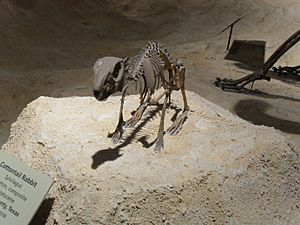
Scientists have grouped cottontail rabbits into different types. These groups were first made in the 1800s based on how the rabbits looked. However, newer studies looking at their genes show that these old groups might not perfectly show how the rabbits are related. Still, these groups are helpful for understanding the different kinds of cottontails.
Here are some of the known species of cottontail rabbits:
| Subgenus | Image | Common name | Scientific name | Where they live |
|---|---|---|---|---|
| Microlagus |  |
Brush rabbit | Sylvilagus bachmani | West coast of North America, from Oregon to the southern tip of Baja California. Also on San José Island. |
| Sylvilagus |  |
Desert cottontail | Sylvilagus audubonii | Western United States (from Montana to Texas) and in Northern and Central Mexico. |
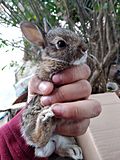 |
Mexican cottontail | Sylvilagus cunicularius | Mexico, from Sinaloa to Oaxaca and Veracruz. | |
 |
Eastern cottontail | Sylvilagus floridanus | Eastern and south-central United States, southern Canada, eastern Mexico, Central America, and northernmost South America. | |
| Tres Marias cottontail | Sylvilagus graysoni | Tres Marias Islands, Mexico. | ||
 |
Mountain cottontail | Sylvilagus nuttallii | Intermountain west of Canada and the United States. | |
 |
Appalachian cottontail or Allegheny cottontail | Sylvilagus obscurus | Eastern United States. | |
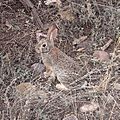 |
Robust cottontail | Sylvilagus holzneri | Southwestern United States and nearby Mexico. | |
 |
New England cottontail | Sylvilagus transitionalis | New England, from southern Maine to southern New York. | |
| Tapeti |  |
Andean tapeti | Sylvilagus andinus | Venezuela south to Peru. |
| Bogota tapeti | Sylvilagus apollinaris | Colombia. | ||
 |
Swamp rabbit | Sylvilagus aquaticus | Southern United States. | |
 |
Common tapeti | Sylvilagus brasiliensis | Brazil (and Venezuela to Argentina if other populations are included). | |
| Ecuadorian tapeti | Sylvilagus daulensis | Ecuador. | ||
| Dice's cottontail | Sylvilagus dicei | Costa Rica and Panama. | ||
| Fulvous tapeti | Sylvilagus fulvescens | Colombia. | ||
| Central American tapeti | Sylvilagus gabbi | Mexico to Panama. | ||
| Northern tapeti | Sylvilagus incitatus | San Miguel Island, Panama. | ||
| Omilteme cottontail | Sylvilagus insonus | Guerrero, Mexico. | ||
| Nicefor's tapeti | Sylvilagus nicefori | Colombia. | ||
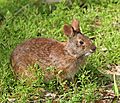 |
Marsh rabbit | Sylvilagus palustris | Southeastern United States. | |
| Suriname tapeti | Sylvilagus parentum | Western Suriname. | ||
| Colombian tapeti | Sylvilagus salentus | Colombia. | ||
| Santa Marta tapeti | Sylvilagus sanctaemartae | Colombia. | ||
| Western tapeti | Sylvilagus surdaster | Ecuador. | ||
| Coastal tapeti | Sylvilagus tapetillus | Rio de Janeiro, Brazil. | ||
| Venezuelan lowland rabbit | Sylvilagus varynaensis | Western Venezuela. |
Cottontails from the Past
Scientists have also found fossils of cottontail rabbits that lived long ago. These are called prehistoric species. Some examples include:
- Sylvilagus hibbardi (from the Early-Mid Pleistocene era)
- Sylvilagus leonensis - also known as the Dwarf cottontail (from the Late Pleistocene era)
- Sylvilagus webbi (from the Pleistocene era)
See also
 In Spanish: Conejos de cola de algodón para niños
In Spanish: Conejos de cola de algodón para niños


